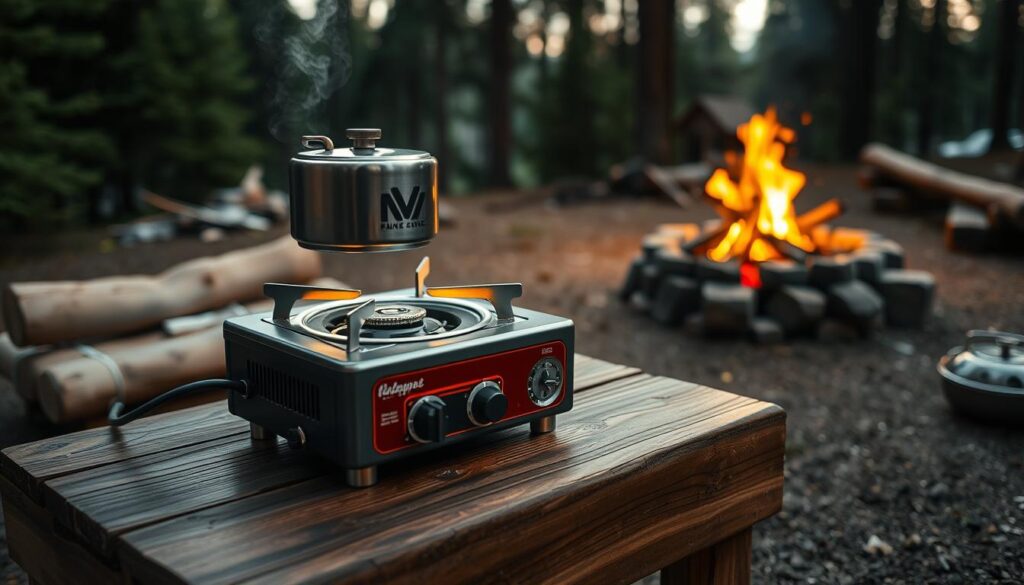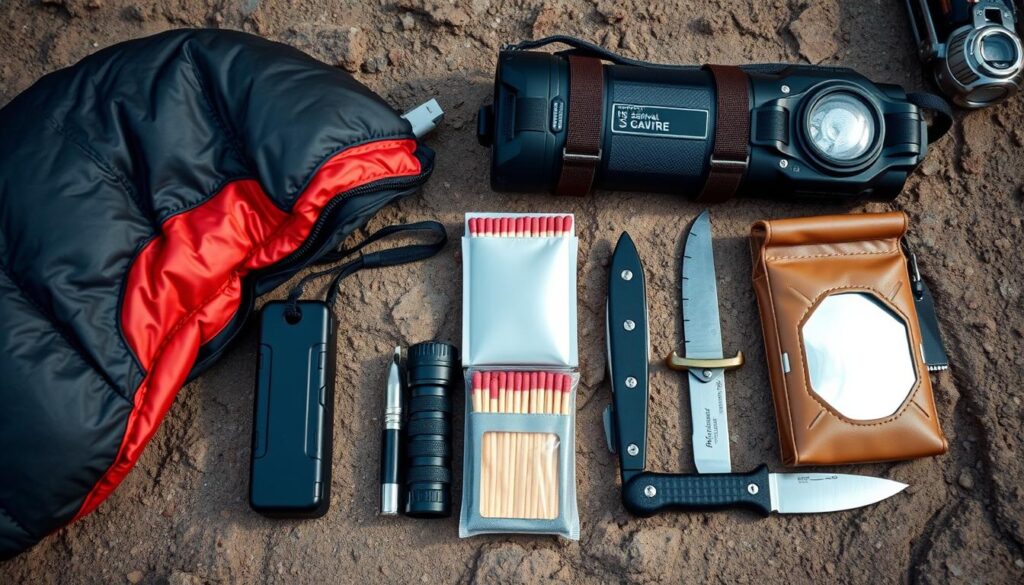Cooking outdoors can be a delightful experience. Having the right gear makes it even better. For outdoor lovers, a camping stove is key for easy and efficient cooking. It’s perfect for short camping trips or long backpacking adventures.
Starting with camping stoves can seem tough, but it’s not. The right portable stove lets you cook hot meals outside. For more tips on camp cooking, check out camp cooking for beginners. It offers great advice for starting out.
Key Takeaways
- Understand the basics of outdoor cooking with a camping stove.
- Learn how to choose the right portable stove for your needs.
- Discover essential tips for cooking efficiently in the outdoors.
- Explore the benefits of using a camping stove for wilderness cooking.
- Find out how to pack the right gear for a camping trip.
What Is a Portable Stove?
A portable stove is a handy cooking tool for outdoor activities. It’s small, light, and simple to use. This makes it a must-have for campers, backpackers, and outdoor fans.
Definition and Purpose
A portable stove lets you cook meals outside, like at campsites or on backpacking trips. It’s made to cook well in any setting.
Key characteristics of a portable stove include:
- Compact design for easy transport
- Lightweight construction for reduced backpack weight
- Simple ignition system for hassle-free startup
- Adjustable flame control for precise heat management
Types of Portable Stoves
There are many types of portable stoves, each for different needs. Here are some common ones:
- Backpacking stoves: These are super small and light, perfect for ultralight backpacking.
- Canister stoves: They use fuel canisters and are known for being easy to use and reliable.
- Liquid fuel stoves: These stoves can use different liquid fuels, giving you flexibility.
- Multi-fuel stoves: They can burn various fuels, making them great for different places.
Why Use a Portable Stove?
For those who love cooking on the move, a portable stove is essential. It lets you make meals anywhere, anytime, without needing a kitchen.
Advantages of Cooking on the Go
Using a portable cooking appliance has many benefits. First, it’s super convenient. You can cook in many places, like campsites or remote spots.
Second, it’s efficient. Many portable stoves use less fuel, which saves you money. Lastly, they’re versatile. They work for all sorts of cooking, from boiling water to searing meat.
- Convenient for outdoor activities like camping and backpacking
- Efficient in terms of fuel consumption
- Versatile for various cooking techniques
Ideal Scenarios for Use
Portable stoves are perfect for many outdoor activities. They’re great for camping and backpacking. You can make hot meals in the wild.
They’re also good for outdoor events, like festivals or tailgating parties. When you can’t get to a kitchen, a portable stove is handy.
- Camping trips
- Backpacking adventures
- Outdoor events like festivals or tailgating parties
Choosing the Right Portable Stove for Me
Finding the right portable stove can seem hard, but knowing what you need helps. When I go camping, I think about a few things. I want a stove that fits my cooking needs.
Key Features to Consider
There are important features to look at when picking a portable stove. The fuel type, cooking area, and how easy it is to carry are key. Fuel type matters a lot because it affects how well the stove works, its safety, and how easy it is to use. For instance, propane stoves are reliable and easy to use, while butane stoves are small and light.
The cooking surface area is also important. If you’re cooking for a group, you’ll need a bigger stove. But if you’re camping alone, a smaller one might be enough. Also, think about how portable the stove is. Look at its weight, size, and how easy it is to set up.
- Fuel type (propane, butane, wood, etc.)
- Cooking surface area
- Portability (weight, size, ease of setup)
- Ignition system (manual, electronic, etc.)
- Wind resistance and stability
Popular Brands and Models
Coleman and MSR are well-known for their portable stoves. They have many models with different features and prices. For example, the Coleman Classic Camp Stove is affordable and reliable. The MSR WhisperLite Universal Stove is great for its performance and versatility.
When looking at different models, think about what you really need. If you’re backpacking, you might want something light and small. If you’re car camping, you might prefer a bigger, more sturdy stove.
By thinking about these things and looking at popular brands and models, you can find the perfect portable stove for your adventures.
Fuel Types for Portable Stoves
Portable stoves come in different fuel types. The fuel you choose affects how well the stove works and how safe it is. It also impacts how easy it is to use in different places.
Propane vs. Butane Stoves
Propane and butane are two common fuels for portable stoves. They are both easy to use and burn cleanly. Propane stoves work well in cold weather because propane turns into vapor easily. Butane stoves are popular because they are simple to use and butane is easy to find.
When picking between propane and butane, think about the weather and where you are. Propane is better in cold places. Butane is easier to use and canisters are more common.
| Fuel Type | Energy Output | Ease of Use | Climate Suitability |
|---|---|---|---|
| Propane | High | Moderate | Cold Climates |
| Butane | Moderate | High | Temperate Climates |
Wood and Charcoal Options
Some portable stoves burn wood or charcoal. These are good for those who like traditional cooking or have access to these fuels. Wood-burning stoves are great for camping and survival. They cook food when gas stoves can’t be used. But, they make more smoke and need more care than gas stoves.
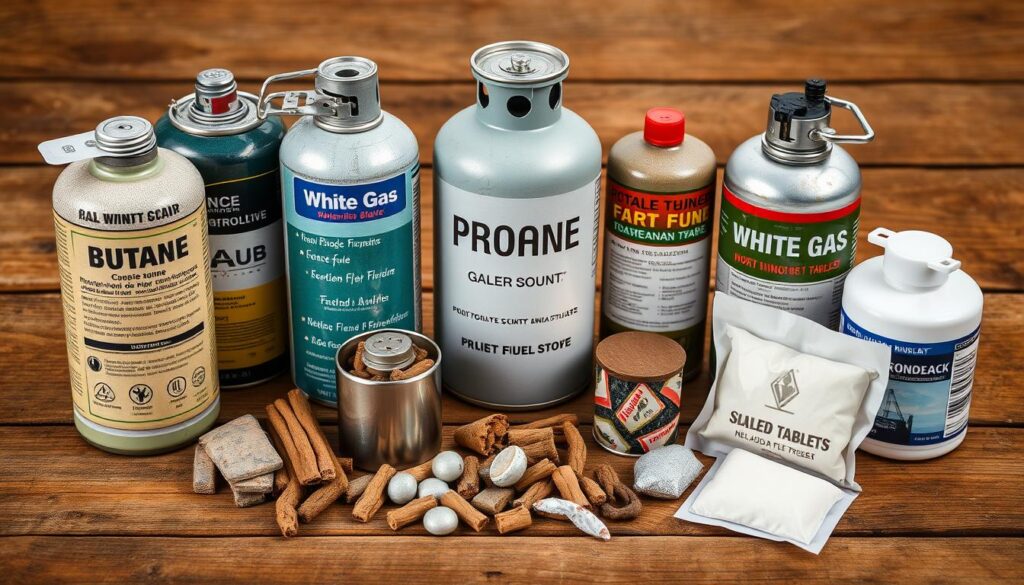
Charcoal stoves mix the ease of a portable stove with the taste of charcoal. They are loved by outdoor cooking fans for the unique flavor they give food.
In summary, the right fuel for a portable stove depends on what you need to cook, where you are, and what you like. Knowing about different fuels helps you pick the best stove for your adventures.
Safety Tips for Using a Portable Stove
Using a portable stove safely means knowing and following important safety rules. This is true whether I’m camping, backpacking, or cooking at home. It’s key to know how to use my portable stove safely.
General Safety Guidelines
First, always pick a stable and flat spot for your stove, away from things that can catch fire. It’s also important to have good air flow to avoid harmful fumes.
When I handle fuel, I must be careful. This means using the right fuel, storing it right, and checking for leaks. It’s also important to check the stove and its parts for damage or wear regularly.
| Safety Measure | Description | Importance Level |
|---|---|---|
| Proper Ventilation | Ensure good airflow around the stove | High |
| Stable Surface | Place stove on a flat, stable surface | High |
| Fuel Handling | Handle fuel with care, check for leaks | High |
| Regular Inspection | Regularly inspect stove and components | Medium |
Common Mistakes to Avoid
Staying safe with a portable stove means avoiding common mistakes. One big error is not following the manufacturer’s instructions. Each stove is different.
Another mistake is not watching the cooking surface temperature. This can cause overheating or fires. Having a fire extinguisher nearby is smart. Also, be careful of the stove’s surroundings to avoid accidents.
Knowing these common mistakes and how to avoid them helps me have a safe and fun outdoor cooking experience with my portable stove.
Setting Up My Portable Stove
To start using my portable stove, I must pick a safe spot and follow some easy steps. It’s important to know what affects the stove’s performance and safety.
Choosing an Appropriate Location
First, I need to find a good spot for my stove. It should be on a flat and stable surface. This keeps the stove safe and working well. I should avoid places that are uneven or sloping.
The area also needs to be well-ventilated. This stops harmful fumes like carbon monoxide from building up.
Next, I must think about wind protection. Wind can mess with the stove’s flame or heat. I should find a spot that blocks the wind, like behind trees or near a building. If that’s not possible, a windscreen can help.
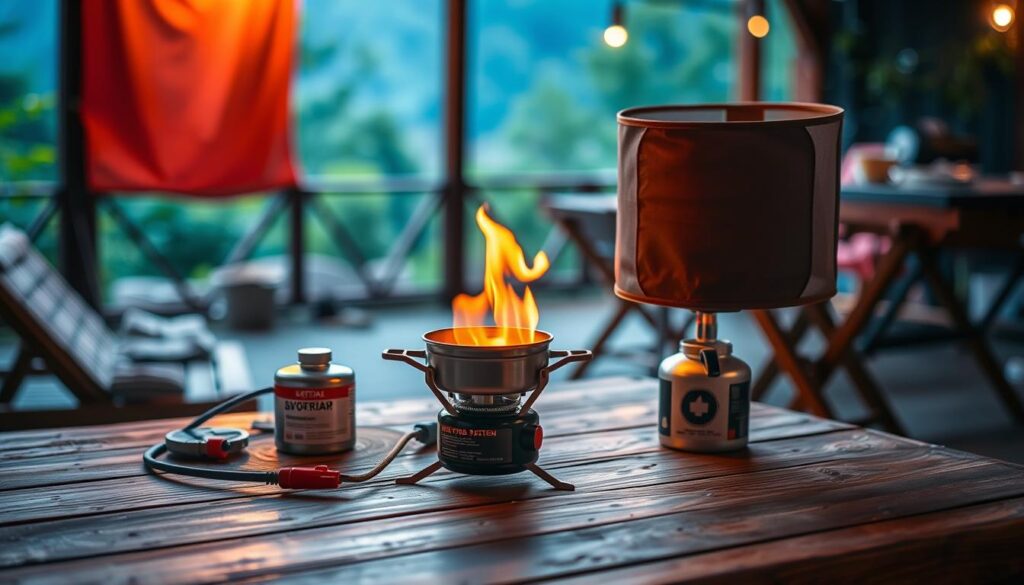
Essential Accessories for Setup
To set up my stove right, I need some essential accessories. First, I need a cooking pot or pan that fits the stove. The cookware should match the stove type, like stainless steel or hard anodized pans.
Then, I need a fuel source. This could be a propane tank, butane canisters, or fuel for a wood or charcoal stove. It’s key to have the right fuel and connect it correctly for safe use.
- A cooking pot or pan compatible with the stove
- A suitable fuel source (e.g., propane tank, butane canisters)
- A windscreen or other forms of wind protection
By picking the right spot and having the right gear, I can cook safely and enjoyably with my portable stove.
Cooking Techniques with My Portable Stove
My portable stove lets me boil, steam, grill, and sear many dishes easily. This makes outdoor cooking fun and flexible. Whether camping or just need a quick cooking solution, it’s perfect.
Boiling and Steaming
Boiling and steaming are simple yet effective with a portable stove. To boil water or cook pasta, fill a pot and place it on the stove. Turn the burner to high. For steaming, use a basket to keep food away from boiling water. This is great for cooking veggies, seafood, and other delicate foods without losing nutrients.
It’s important to watch the heat and adjust as needed. Most stoves let you control the heat, which helps prevent overcooking or scorching.
Grilling and Searing
Grilling and searing add smoky flavor and texture to dishes. I often use a cast-iron skillet or grill pan for this. Preheating the pan is key to get a good sear and prevent sticking.
A key tip is not to overcrowd the pan. Cooking in batches if needed, ensures each piece cooks evenly. This is great for cooking proteins like steak, chicken, or fish, where a good sear is important for flavor and presentation.
| Cooking Technique | Best For | Key Considerations |
|---|---|---|
| Boiling | Pasta, potatoes, and tough vegetables | Monitor heat to prevent overcooking |
| Steaming | Delicate foods, seafood, and vegetables | Use a steamer basket to keep food out of water |
| Grilling/Searing | Meats, achieving a nice crust | Preheat pan, don’t overcrowd |
Meal Ideas for Portable Stoves
A portable stove is more than just for survival. It opens up a world of outdoor cooking. You can cook anywhere and enjoy many different meals.
Breakfast on the Go
Starting your day with a good breakfast is simple with a portable stove. You can scramble eggs, make coffee, or even pancakes. For a quick choice, try oatmeal with dried fruits and nuts.
Other breakfast ideas include:
- Avocado toast with a fried egg
- Breakfast burritos with sausage or bacon
- French toast with maple syrup
Lunch and Dinner Options
Lunch and dinner offer endless choices. Try one-pot meals like pasta, risotto, or chili. They’re tasty and easy to clean up. Grilled meats and veggies are also great, for a healthy meal.
Here are some lunch and dinner ideas:
- Grilled chicken or fish with roasted veggies
- Stir-fries with your favorite protein and veggies
- Tacos with seasoned ground beef or chicken
Plan your meals with what you have and how long you have to cook. A portable stove lets you get creative. Try new recipes and flavors.
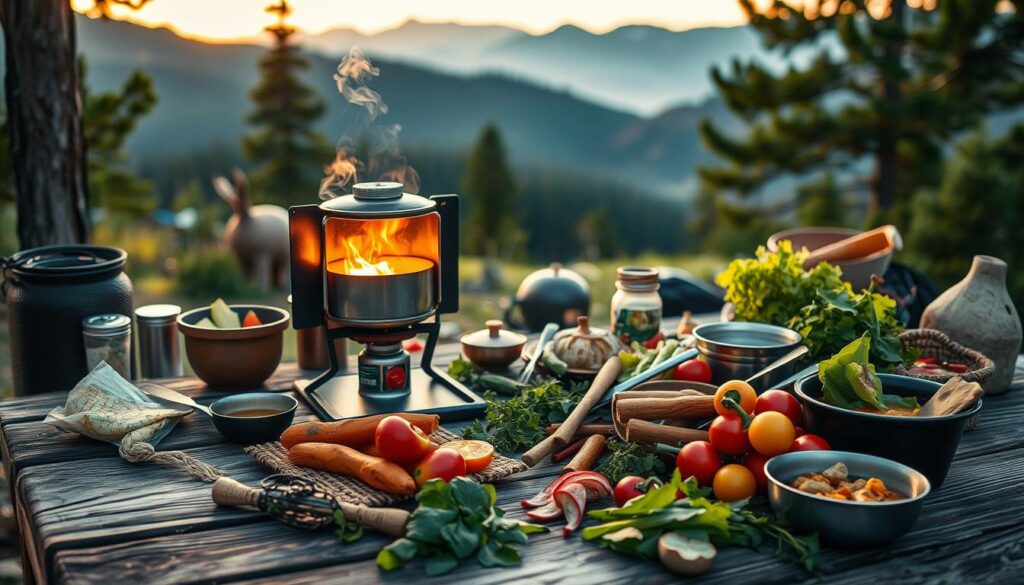
Whether camping, backpacking, or having a picnic, a portable stove makes outdoor cooking better. With some planning and creativity, you can have many delicious meals on the go.
Cleaning and Maintaining My Portable Stove
Keeping my portable stove clean is key to its performance. It’s not just about cleanliness; it’s about reliability on outdoor trips. Regular care extends its life and keeps it working well.
Daily Cleaning Routine
After every use, I clean my portable stove. I wipe the cooking surface with a damp cloth to get rid of food bits. For stoves with complex designs, a soft brush helps clean between the burner and the stove’s body.
For stoves with fuel tanks, like a camping stove, checking the tank is vital. I look for leaks and make sure the tank is tight to avoid accidents.
Long-Term Maintenance Tips
While daily cleaning is important, long-term care is also necessary. Inspecting and cleaning the fuel system regularly is a must. For propane or butane stoves, check the jets and burner for blockages. A can of compressed air can help clear out debris.
Proper storage is also key when not using my portable stove. I dry it well to avoid rust, store it in a dry spot, and keep it away from extreme temperatures. For stoves with removable parts, like grills, I clean and store them separately to prevent damage.
By sticking to these maintenance tips, my portable stove stays in top shape for my next outdoor cooking trip. Regular care saves money and ensures hassle-free cooking on the go.
Trouble-Shooting Common Issues
Learning to fix common problems with your portable stove can make outdoor cooking better. Whether you’re camping or cooking in a remote area, knowing how to solve issues quickly is key.
Ignition Problems
Ignition issues are common for portable stove users. If your stove won’t light, first check the fuel level. Make sure the fuel valve is open and there’s enough fuel. If it’s not working, look for blockages or damage in the igniter.
Common Causes of Ignition Failure:
- Clogged burner or igniter
- Insufficient fuel
- Faulty ignition switch
If you think the burner is clogged, clean it with a soft brush or replace it if needed. For stoves with piezoelectric ignition, make sure the igniter works right.
| Issue | Possible Cause | Solution |
|---|---|---|
| Stove won’t ignite | Low fuel or clogged burner | Check fuel level, clean burner |
| Igniter not sparking | Faulty ignition switch or battery issue | Check or replace the ignition switch or battery |
Uneven Heating Solutions
Uneven heating can ruin your meals and make cooking frustrating. First, make sure your cooking pot fits your portable stove. Using a pot that’s too big or too small can cause uneven heating.
Tips for Achieving Even Heating:
- Use a pot that’s appropriately sized for your stove
- Adjust the flame to a suitable level
- Ensure the stove is on a stable, flat surface
If your stove keeps heating unevenly, check the burner for debris or damage. Cleaning the burner or adjusting the flame can often fix the problem.
| Symptom | Cause | Fix |
|---|---|---|
| Uneven cooking | Incorrect pot size or unstable stove | Adjust pot size, stabilize stove |
| Flame too high or low | Incorrect fuel regulation | Adjust fuel valve |
Frequently Asked Questions about Portable Stoves
Thinking about using a portable stove for your outdoor adventures? You might wonder about their safety and how to use them. I’ll cover some common questions to help you get the most out of your portable stove.
Indoor Safety Concerns
Are portable stoves safe indoors? Most portable stoves are made for outdoor use. But, some can be used in places with good air flow. Always check the maker’s advice on indoor use.
Camping with Portable Stoves
Can I camp with a portable stove? Yes, they’re perfect for camping and cooking outside. They make cooking meals in nature easy and efficient. Look for a camping stove that’s strong and has a good fuel source.
Knowing the answers to these questions will help you cook safely and effectively outdoors with your portable stove.
FAQ
What is a portable stove, and how does it work?
A portable stove is a small, light cooking tool for outdoor meals. It uses fuel like propane, butane, or wood to heat up for cooking.
What are the benefits of using a portable stove for camping or backpacking?
Portable stoves are great for outdoor cooking. They are easy to use, efficient, and versatile. They’re perfect for camping, backpacking, or any outdoor cooking need.
How do I choose the right portable stove for my needs?
To pick the right stove, think about fuel type, power, weight, and size. Look at popular brands and read reviews to find the best one for you.
What are the different types of fuel used in portable stoves, and what are their advantages and disadvantages?
Portable stoves use fuels like propane, butane, wood, and charcoal. Propane and butane stoves are easy and efficient. Wood and charcoal stoves give a traditional cooking feel.
How do I ensure safety when using a portable stove?
To stay safe with a portable stove, handle fuel right, keep the cooking area safe, and make sure there’s good air flow.
Can I use a portable stove indoors?
Some portable stoves can go indoors with good air flow. But always follow the maker’s rules and be careful.
How do I clean and maintain my portable stove?
To keep your stove clean, do daily cleaning and long-term upkeep. This includes cleaning the fuel system and the cooking surface.
What are some common issues with portable stoves, and how can I troubleshoot them?
Issues like not lighting or uneven heat are common. Check the fuel, cooking surface, and air flow. Do any needed maintenance to fix these problems.
Are portable stoves suitable for cooking a variety of meals?
Yes, portable stoves are very versatile. You can boil, steam, grill, or sear many dishes. They’re great for breakfast, lunch, and dinner.

